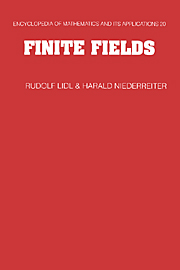Book contents
- Frontmatter
- Contents
- Foreword
- Preface
- Chapter 1 Algebraic Foundations
- Chapter 2 Structure of Finite Fields
- Chapter 3 Polynomials over Finite Fields
- Chapter 4 Factorization of Polynomials
- Chapter 5 Exponential Sums
- Chapter 6 Equations over Finite Fields
- Chapter 7 Permutation Polynomials
- Chapter 8 Linear Recurring Sequences
- Chapter 9 Applications of Finite Fields
- Chapter 10 Tables
- Bibliography
- List of Symbols
- Author Index
- Subject Index
Chapter 2 - Structure of Finite Fields
Published online by Cambridge University Press: 02 November 2009
- Frontmatter
- Contents
- Foreword
- Preface
- Chapter 1 Algebraic Foundations
- Chapter 2 Structure of Finite Fields
- Chapter 3 Polynomials over Finite Fields
- Chapter 4 Factorization of Polynomials
- Chapter 5 Exponential Sums
- Chapter 6 Equations over Finite Fields
- Chapter 7 Permutation Polynomials
- Chapter 8 Linear Recurring Sequences
- Chapter 9 Applications of Finite Fields
- Chapter 10 Tables
- Bibliography
- List of Symbols
- Author Index
- Subject Index
Summary
This chapter is of central importance since it contains various fundamental properties of finite fields and a description of methods for constructing finite fields.
The field of integers modulo a prime number is, of course, the most familiar example of a finite field, but many of its properties extend to arbitrary finite fields. The characterization of finite fields (see Section 1) shows that every finite field is of prime-power order and that, conversely, for every prime power there exists a finite field whose number of elements is exactly that prime power. Furthermore, finite fields with the same number of elements are isomorphic and may therefore be identified. The next two sections provide information on roots of irreducible polynomials, leading to an interpretation of finite fields as splitting fields of irreducible polynomials, and on traces, norms, and bases relative to field extensions.
Section 4 treats roots of unity from the viewpoint of general field theory, which will be needed occasionally in Section 6 as well as in Chapter 5. Section 5 presents different ways of representing the elements of a finite field. In Section 6 we give two proofs of the famous theorem of Wedderburn according to which every finite division ring is a field.
Many discussions in this chapter will be followed up, continued, and partly generalized in later chapters.
CHARACTERIZATION OF FINITE FIELDS
In the previous chapter we have already encountered a basic class of finite fields—that is, of fields with finitely many elements.
Information
- Type
- Chapter
- Information
- Finite Fields , pp. 47 - 82Publisher: Cambridge University PressPrint publication year: 1996
